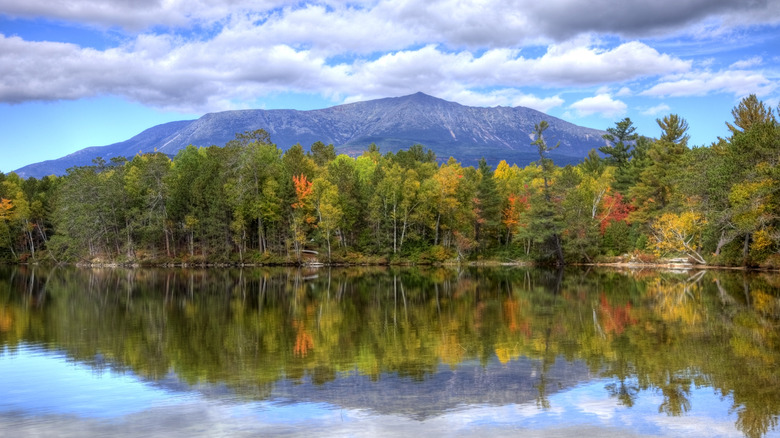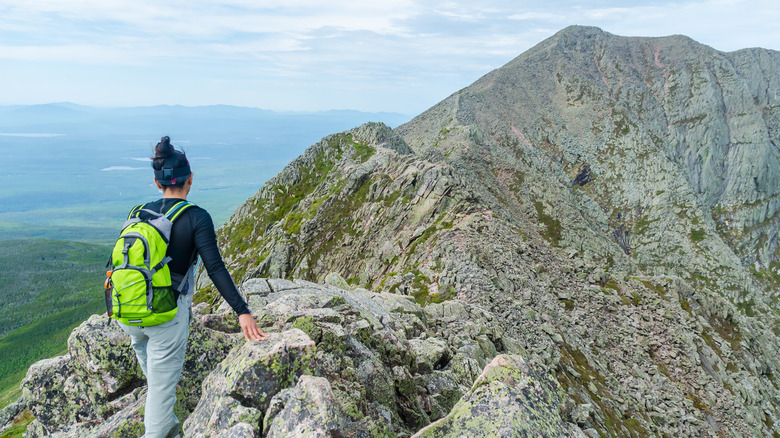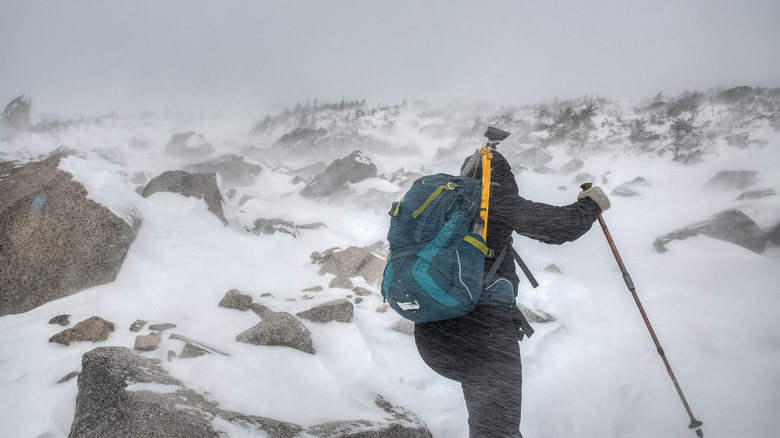Why Winter Hiking In This East Coast Region Isn't For The Faint Of Heart
Situated at the northern end of the epic Appalachian Trail, Mount Katahdin is a popular destination for hikers who want to test their nerve. Sitting in the middle of the majestic Baxter State Park, the peak is surrounded by 235,000 acres of beautiful wilderness and over 350 miles of trails, but the big draw for many visitors to this East Coast region is the mountain itself.
On paper, the picturesque peak — which translates to "Greatest Mountain" in the Penobscot language — might not seem all that daunting. Although it is the highest summit in the state of Maine at 5,269 feet, it is dwarfed by the tallest mountains in the United States. It also stands a fair bit smaller than other peaks in the Northeast that carry a fearsome reputation like Mount Washington (6,288 feet), known as "the most dangerous small mountain in the world."
Most hikers attempt Mount Katahdin in the summer when the weather is fine and the days are long. For some hardy and intrepid souls, tackling the peak in the snow is where the adventure is really at. A trail as rugged as the one leading to the summit at Baxter Peak needs treating respect at any time of year, and that goes double in the winter — especially when the mountain has one particularly treacherous challenge waiting in store: Knife Edge.
Why is the Knife Edge so dangerous?
Despite the mountain's relatively small size, experts warn that some visitors may face more of a challenge making it to the top of Mount Katahdin than they might while tackling some of the big fourteeners in the United States. It represents the last leg of the approximately 2,200-mile footpath we know as the Appalachian Trail and hikers joining the route in Baxter State Park usually begin their ascent on the Hunt Trail, the most popular of five complete trails.
Around 30,000 visitors each year accept the challenge to climb Mount Katahdin and most treks are completed without incident, but it does require a certain level of physical fitness: the round trip usually takes between 8 to 12 hours in total, and longer in the winter.
For those who want to experience the notorious Knife Edge, however, the demanding route of the Helon Taylor + Knife Edge Trail is the way to go. The Knife Edge itself is a mile-long ridge scramble varying from grade 2 to 3 in difficulty, stretching from Pamola Peak over Chimney Peak and South Peak before reaching the summit at Baxter Peak. Faced with deadly drops on either side, the route gets "as narrow as a lobster trap" in certain sections, according to Northeast Hikes. Needless to say, proper hiking boots and constant vigilance are required if you decide to take on the Knife Edge — more than 60 people have died on the arête between 1926 and 2023.
Tackling Mount Katahdin in winter
Darkness and wintry conditions can make a poorly-lit sidewalk pretty treacherous, so Mount Katahdin and the notorious Knife Edge in bad weather represent a dangerous mission that even experienced climbers call "the scariest hiking trail in the East," according to Down East. It can be deadly even without snow; in October 2020, two hikers died in the space of a few days. One man perished on Baxter Peak while another succumbed to his injuries after falling from Knife Edge in dark and foggy conditions.
In the winter months, Mount Katahdin experiences extreme conditions similar to Mount Washington in New Hampshire, with heavy snowfall, strong winds, freezing temperatures, poor visibility, and the added danger of avalanches. Park Authorities recommend that anyone hiking on the mountain in fall or winter comes properly equipped with appropriate clothing, food, and water, and sticks to an early turnaround time to avoid descending in the dark. A winter ascent understandably needs far more equipment including snowshoes, crampons, an ice axe, and a sleeping bag suitable for snowy conditions — an overnight stay at a mountainside camp may be required.
In such conditions, traversing Knife Edge can be even more hazardous with snow, ice, and high winds threatening to send you tumbling from the ridge. Whichever route you take to the summit, it requires fortitude and independence because cell phone and radio signals are unreliable and rescue becomes more difficult if you get in trouble. Provided you stay safe and prepare correctly, however, you are guaranteed an incredible adventure.


